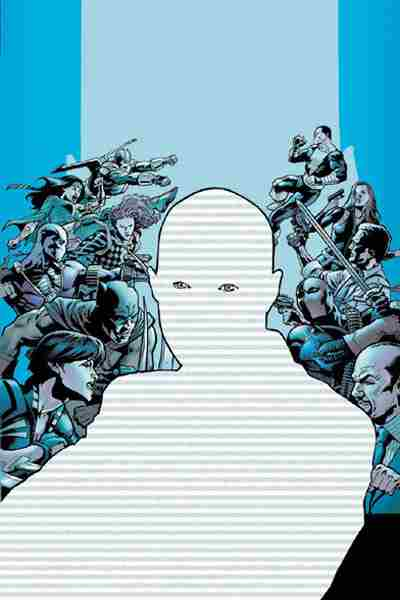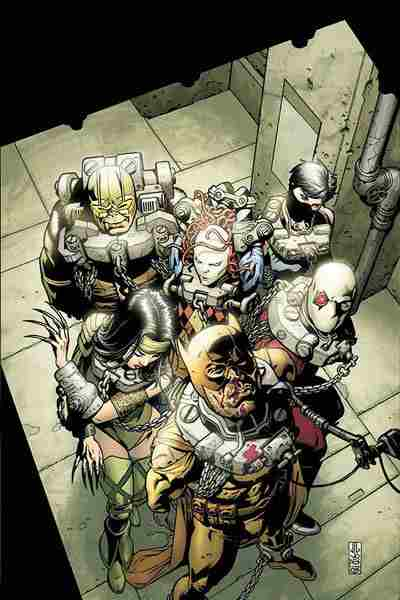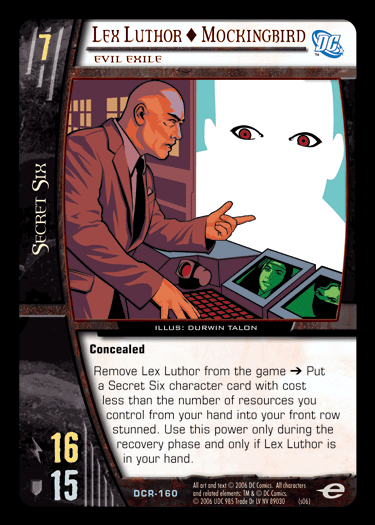
Do you want to know a secret? Those seven words work every time. I grabbed your attention and I will hold it for as long as I can keep your interest. You enjoy the anxious anticipation of the information that is hidden from you. The unrevealed answer lights the fire of desire. Everyone loves a secret.
When DC Comics revived the Secret Six affiliation for the Villains United series in the spring of 2005, they created a firestorm of conjecture that quickly burned up all the comic myth message boards by teasing the world senseless with a hidden character. In other words, no one had a clue who Mockingbird really was. He formed the Secret Six, manipulated them with the cruelest of blackmail, and sent them out to oppose the Society . . . all from a video screen that only revealed his eyes. Even the members of the team were kept in the dark about who their leader was. They suspected each other.

The Secret Six has always been a group of villains linked together by the bond of evil motives. Their stories are seedy, sordid affairs. Each incarnation of this timeless team affiliation has suffered the same fate and portrayed the same failings as its predecessor. These are not pretty stories.
In the Villains United series, a disgustingly manipulative Mockingbird formed the third incarnation of the Secret Six in order to undercut the mind-wiping plans of the new über-team of bad guys known as the Society. He recruited Deadshot, Scandal, Cheshire, Ragdoll 3, Fiddler, and one of Granny Goodness’s Parademons. Whoever Mockingbird was, he was viciously cruel in reinforcing his power over the team. He actually threatened to squeal on the Parademon, who had skipped school in Apokolips to see the world. Despicable tactics were used to maintain control over each and every villain. After only the first issue, Mockingbird had already judged Fiddler unworthy, and Deadshot was forced to execute his own teammate. Catman was muscled into the Secret Six immediately to keep their numbers up.

The original Secret Six was created from the clay of cold-blooded domination in 1968. A phantom group called The Agency infected Dr. August Durant with a deadly virus. Then they blackmailed him with the cure. Durant became the first Mockingbird and recruited a team of mercenaries to serve The Agency. Each of the team members was psychologically and physically indebted to Mockingbird, although his identity was always a secret. The members of the Secret Six were little more than deadly slaves; they only kept their allegiance because of Mockingbird’s despicable threats and manipulation. The affiliation was revived twenty years later in Action Comics, and it followed the same unseemly pattern with a new secret Mockingbird.
Jumping ahead nearly twenty years again, Villains United warmed and watered the same evil seed into a monstrous growth of sickness. The new mysterious Mockingbird had plans of his own, although those were a secret, too. Each of the members was tortured both mentally and physically to remain loyal. They turned on each other when the stress became unbearable. Their supposed mission was to infiltrate and destroy the Society. Each of the Secret Six members was suspicious of the others, and for good reason. One of them could be Mockingbird, the author of their miserable bondage. One of them was actually a spy from the Society. All of them were true villains, but they were never really united. They were the nastiest of characters, and they treated each other very badly.
They were, however, very good at their jobs.
Mockingbird’s primary occupation as the guiding force behind the Secret Six is always the same. He keeps the guessing game going. He selected the Villains United lineup because they each possessed different valuable skills and experiences. This was necessary in the battle against the Society. Mockingbird scored major victories due to his incredibly wicked recruitment skills, without any of his crew ever knowing who he was.
Lex Luthor was guiding the Society that Mockingbird was plotting to destroy. It looked like Lex Luthor, anyway. The actual mastermind behind the worldwide mind-wipe movement that triggered countless crises across all of DC Comic continuity was, in fact, Alexander Luthor—Lex’s son by Lois Lane. The eventual revelation that the original sexy Lexy was in fact the secret Mockingbird was cheered and celebrated as a spectacular surprise by fans the world over. The storylines became a Hall of Mirrors that exploded into an ecstatic epiphany of imaginary identity. It will remain one of the highlights of sequential art history forever.
Lex Luthor’s adventures as Mockingbird in Vs. System promise to start an amazing new adventure for the Secret Six. As long as you can convince a character to become affiliated with his team, Lex Luthor ◊ Mockingbird can alternately recruit it from your hand, no matter what its cost.

That is a bold ability that obviously needs a number of limits associated with it.* The power to allow a character to come into play can only be used if Lex Luthor ◊ Mockingbird is in your hand. The character that you get without paying any resources must have the Secret Six affiliation. The cost of the card you put into play must be less than the number of resources you control, and it must go into your front row. Heaviest of all, the character is put into play stunned and the ability can only be used during the recovery phase.
The upside to all those restrictions is intriguing. Alternate recruitment bypasses uniqueness. If you have a favorite non-Army character card of which you have always itched get more than one copy into play, this is yet another chance. This is one of less than ten cards in all of Vs. System that can allow two or more Longshots to get lucky simultaneously from your side of the board without stealing them from your opponent. It has me dreaming of multiple Mulletmen already.
What would I do with Mockingbird’s effect? Well, there are ways to recover the stunned character using the X-Men abilities and Harry’s Hideaway. Perhaps I could have both the 4-drop and the 6-drop versions of Dr. Doom in play at the same time. I can imagine a free Anti-Green Lantern or Xallarap that would already have its text box turned off for safety. There’s also the frightening possibility of control characters that return to hand, like Captain Boomerang, George Harkness, and also the shocking idea of multiple copies of Electric Eve and her fellow evaders. I also thought of combo’ing Mockingbird with Mammoth, but then I found out about the upcoming errata.**
If your first concern is for recovery of the character that is put into play stunned, you can use Children of the Atom tricks, Home Surgery, Club Dead, Rebirth, and Muir Island. I also think Alfred Pennyworth would enjoy working with this version of Lex. Mockingbird could mean a lot to the future of creative deckbuilding. There’s the possibility of a pair of Sinestro, Green Lantern of Korugars using Lanterns in Love and creating something I like to call “Ker-stun”! I immediately fainted at the thought of that. To end this article, I’ll just mention that the ability of Longshot, Rebel Freedom Fighter would work really well with a copy of Longshot, Hero of Mojoworld in play beside it.
Okay. I am awake again. What did I miss? Do we know who Mockingbird really is yet?
Rian Fike is always hiding behind the scenes, waiting to reveal his secret identity to the world. Too bad he has not figured it out yet himself. If you have any theories, send them to rianfike@hattch.com.
* Here’s an excerpt from the Infinite Crisis FAQ that clarifies what you can do with Mockingbird’s effect:
Lex Luthor ◊ Mockingbird can put a character into play stunned. If a character comes into play stunned, then:
- if it has a power that triggers when it comes into play, that power does not trigger;
- it does not become stunned while in play, so it does not cause stun endurance loss;
- powers that trigger whenever a character becomes stunned do not trigger;
- it does not come into play with a cosmic counter.
** Mammoth has received the following erratum that goes into effect on April 26 (the bold text denotes the change): “As an additional cost to recruit Mammoth, reveal a Fearsome Five character card from your hand. When Mammoth comes into play, KO a resource you control, and when Mammoth is put into a KO’d pile from play, put the top card of your deck face down into your resource row. Whenever Mammoth becomes stunned, KO him.” The new text moves Mammoth’s leaves-play power into the same paragraph as his comes-into-play power, changing his leaves-play power into a delayed triggered modifier that’s created when he comes into play (but not if he comes into play stunned). In other words, if he comes into play stunned, you don’t KO a resource, but you also don’t gain a resource when he’s put into a KO’d pile from play.
Tomorrow's Preview: